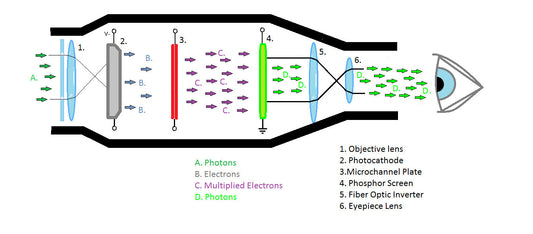... One year after the event with FTS a new era of electronic night fighting just began.
Members of our team started to buy night vision equipment. At first, the number of night vision devices was small, usually one or two units per team. At night, the teams without this equipment were hiding from the "seeing in the dark" predators.
As a team equipped with NVD we started to invent a variety of methods to use one device for a benefit of the entire group. The lack of money for good equipment has forced us to develop many tricks very useful for combat.
I will describe more tricks later in this blog, so if you are curious, just look here from time to time.
Our first night vision device.
The first device bought by our group was a very cheap and primitive monocular, something between generation 0 and generation 1, and we were very proud of it until we started using it in a very dense forest.
Under such conditions our night vision was very poor performance without an IR illumination. However if we wanted to use the IR in the thicket, a beam acted like a flashlight on the bushes just in front of us - we saw bushes and nothing behind them.
If you want to fight with night vision devices, you should know their advantages and weaknesses. Infrared illumination can be seen in other night vision devices like a simple beam of light from a flashlight. So if you have cheap night vision device generation zero or one, you can still effectively detect many of other night vision devices in low light conditions.
As I wrote before the lack of money for good equipment has forced us to develop many tricks very useful for combat. One method was to move around in a compact group where in the center was a night vision operator. In the event of a threat, the night vision operator gave the signal and the other players in the group, for example, raised their hands to be clearly identified as a friend. Then the night vision operator opened fire to other people who did not raise their hands.
Our other trick was to provoke the opponent to give his first shot and reveal his position. Unfortunately echo in the forest can be deceptive, and often the sound can be heard from a different side than the actual sound source.
Therefore one of our tools was a specially designed doll that consisted of tactical flashlight, plywood, piece of wood covered by matting and metal sheet. On the front of doll was a metal and flashlight, on the left side was plywood and on the right side was the piece of wood covered by matting. The flashlight switch was installed at the end of the cable, which had several meters. We called that doll ED - "Enemy Detector". One person was away from the group and at some time turned on the flashlight and illuminated the area.
When someone shot a doll, we could identify the noise and at the same time the direction from which the shot was made.
Another trick was simple and consisted in preparing a trap for the opponent.
The method was very useful in situations where we wanted a moment of rest and for make the trap we needed a cord only. Around the camp we attached to the trees our rifles, flashlights, camera flashes, flares, etc. When the opponent entered the trap and, for example, by his leg caught the string, the rifle started firing at him, or switched on the torch or fired the flare.
Camera flashes were such an invaluable ally because they were blind to both: ordinary opponents and night vision operators. With time, we began to put in complete sets of cameras with flash. Later during a meetings with friends we used to laugh at the surprised or frightened faces of the opponents during an unexpected flash.
... (to be continued)

